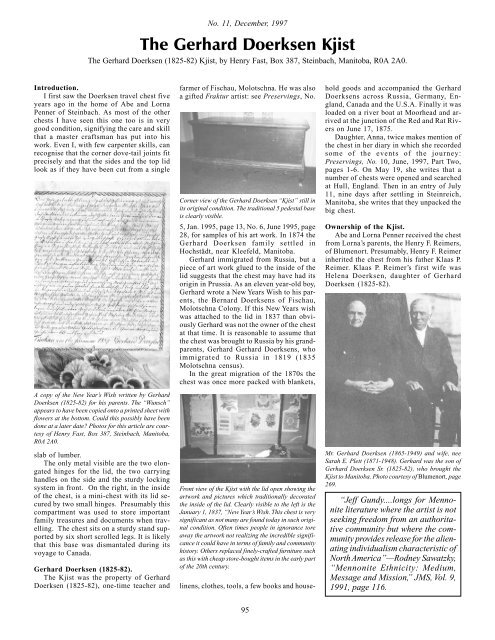Preservings 11 (1997) - Plett Foundation
Preservings 11 (1997) - Plett Foundation
Preservings 11 (1997) - Plett Foundation
You also want an ePaper? Increase the reach of your titles
YUMPU automatically turns print PDFs into web optimized ePapers that Google loves.
No. <strong>11</strong>, December, <strong>1997</strong><br />
The Gerhard Doerksen Kjist<br />
The Gerhard Doerksen (1825-82) Kjist, by Henry Fast, Box 387, Steinbach, Manitoba, R0A 2A0.<br />
Introduction.<br />
I first saw the Doerksen travel chest five<br />
years ago in the home of Abe and Lorna<br />
Penner of Steinbach. As most of the other<br />
chests I have seen this one too is in very<br />
good condition, signifying the care and skill<br />
that a master craftsman has put into his<br />
work. Even I, with few carpenter skills, can<br />
recognise that the corner dove-tail joints fit<br />
precisely and that the sides and the top lid<br />
look as if they have been cut from a single<br />
A copy of the New Year’s Wish written by Gerhard<br />
Doerksen (1825-82) for his parents. The “Wunsch”<br />
appears to have been copied onto a printed sheet with<br />
flowers at the bottom. Could this possibly have been<br />
done at a later date? Photos for this article are courtesy<br />
of Henry Fast, Box 387, Steinbach, Manitoba,<br />
R0A 2A0.<br />
slab of lumber.<br />
The only metal visible are the two elongated<br />
hinges for the lid, the two carrying<br />
handles on the side and the sturdy locking<br />
system in front. On the right, in the inside<br />
of the chest, is a mini-chest with its lid secured<br />
by two small hinges. Presumably this<br />
compartment was used to store important<br />
family treasures and documents when travelling.<br />
The chest sits on a sturdy stand supported<br />
by six short scrolled legs. It is likely<br />
that this base was dismantaled during its<br />
voyage to Canada.<br />
Gerhard Doerksen (1825-82).<br />
The Kjist was the property of Gerhard<br />
Doerksen (1825-82), one-time teacher and<br />
farmer of Fischau, Molotschna. He was also<br />
a gifted Fraktur artist: see <strong>Preservings</strong>, No.<br />
Corner view of the Gerhard Doerksen “Kjist” still in<br />
its original condition. The traditional 5 pedestal base<br />
is clearly visible.<br />
5, Jan. 1995, page 13, No. 6, June 1995, page<br />
28, for samples of his art work. In 1874 the<br />
Gerhard Doerksen family settled in<br />
Hochstädt, near Kleefeld, Manitoba.<br />
Gerhard immigrated from Russia, but a<br />
piece of art work glued to the inside of the<br />
lid suggests that the chest may have had its<br />
origin in Prussia. As an eleven year-old boy,<br />
Gerhard wrote a New Years Wish to his parents,<br />
the Bernard Doerksens of Fischau,<br />
Molotschna Colony. If this New Years wish<br />
was attached to the lid in 1837 than obviously<br />
Gerhard was not the owner of the chest<br />
at that time. It is reasonable to assume that<br />
the chest was brought to Russia by his grandparents,<br />
Gerhard Gerhard Doerksens, who<br />
immigrated to Russia in 1819 (1835<br />
Molotschna census).<br />
In the great migration of the 1870s the<br />
chest was once more packed with blankets,<br />
Front view of the Kjist with the lid open showing the<br />
artwork and pictures which traditionally decorated<br />
the inside of the lid. Clearly visible to the left is the<br />
January 1, 1837, “New Year’s Wish. This chest is very<br />
significant as not many are found today in such original<br />
condition. Often times people in ignorance tore<br />
away the artwork not realizing the incredible significance<br />
it could have in terms of family and community<br />
history. Others replaced finely-crafted furniture such<br />
as this with cheap store-bought items in the early part<br />
of the 20th century.<br />
linens, clothes, tools, a few books and house-<br />
95<br />
hold goods and accompanied the Gerhard<br />
Doerksens across Russia, Germany, England,<br />
Canada and the U.S.A. Finally it was<br />
loaded on a river boat at Moorhead and arrived<br />
at the junction of the Red and Rat Rivers<br />
on June 17, 1875.<br />
Daughter, Anna, twice makes mention of<br />
the chest in her diary in which she recorded<br />
some of the events of the journey:<br />
<strong>Preservings</strong>, No. 10, June, <strong>1997</strong>, Part Two,<br />
pages 1-6. On May 19, she writes that a<br />
number of chests were opened and searched<br />
at Hull, England. Then in an entry of July<br />
<strong>11</strong>, nine days after settling in Steinreich,<br />
Manitoba, she writes that they unpacked the<br />
big chest.<br />
Ownership of the Kjist.<br />
Abe and Lorna Penner received the chest<br />
from Lorna’s parents, the Henry F. Reimers,<br />
of Blumenort. Presumably, Henry F. Reimer<br />
inherited the chest from his father Klaas P.<br />
Reimer. Klaas P. Reimer’s first wife was<br />
Helena Doerksen, daughter of Gerhard<br />
Doerksen (1825-82).<br />
Mr. Gerhard Doerksen (1865-1949) and wife, nee<br />
Sarah E. <strong>Plett</strong> (1871-1948). Gerhard was the son of<br />
Gerhard Doerksen Sr. (1825-82), who brought the<br />
Kjist to Manitoba. Photo courtesy of Blumenort, page<br />
269.<br />
“Jeff Gundy....longs for Mennonite<br />
literature where the artist is not<br />
seeking freedom from an authoritative<br />
community but where the community<br />
provides release for the alienating<br />
individualism characteristic of<br />
North America”—Rodney Sawatzky,<br />
“Mennonite Ethnicity: Medium,<br />
Message and Mission,” JMS, Vol. 9,<br />
1991, page <strong>11</strong>6.
















